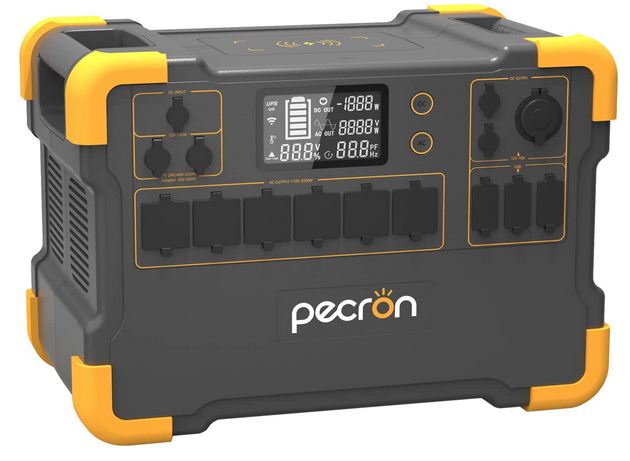Looking for a good deal on a high-capacity and versatile solar generator?
I recommend the Pecron E3000. It’s a great bargain compared to many similar sized solar generators like the Goal Zero Yeti 3000X.
The E3000 is powerful enough to power appliances, comes with a large 3.1kWh Li-ion battery pack, has 16 outlets, and offers multiple fast charging options.
It’s one of the most versatile solar power stations I have reviewed. It’s heavier than most other portable power stations, but not too heavy that you can’t take it with you camping or on road trips.
With its high capacity, the Pecron E3000 is also a great pick for home backup.
Keep reading for my full review of the Pecron E3000, including what I like and don’t like about it plus how it compares to other power stations.
If the E3000 is not what you are looking for, see my reviews of the best home backup solar generators and the best solar generators for camping.
Pecron E3000 Pros & Cons
Pros
Cons
Best Features
3108Wh Li-ion Battery Pack
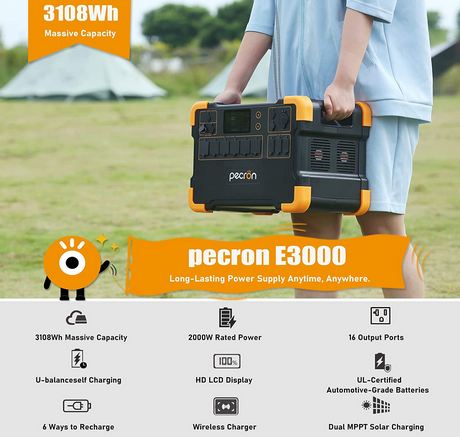
The Pecron E3000 has an impressive capacity of 3108Wh or 3.1kWh. That’s a lot of capacity; enough to give you hours or days of power in an emergency, in your RV or camper van or when you are out camping.
The high capacity also lets you run large appliances like a fridge, microwave, and coffee maker without worrying that the battery will drain too fast.
The Pecron E3000 uses a Li-ion NMC battery pack. While not as long lasting as a LiFePO4 battery, it is lighter, which helps keep the E3000 fairly portable.
What Can The Pecron E3000 Power?
Appliance/device | Run time/recharges |
CPAP (60W) | 44hrs |
Fridge (180W) | 14.6hrs |
Washing machine (1150W) | 2.3hrs (1-2 washes) |
Smartphone (10Wh) | 264 recharges |
Laptop (60Wh) | 44 recharges |
Power tool (1000W) | 2.6hrs |
TV (125) | 21hrs |
2000W Power Output
The Pecron E3000 can power most household appliances including a full size refrigerator, TV, cooker, washer, heater and so on.
You may want to be careful plugging in high-consumption items like a dryer, heater or electric grill that run continuously. While the E3000 can power these appliances, they’ll drain the battery too quickly.
The Pecron E3000 has a surge capacity of 4000W, so it can handle things like power tools that have a high startup draw.
16 Outlets

The Pecron E3000 has one of the highest number of outlets we have seen on a solar generator. The output options are not just plenty, they are also versatile. This lets you power or charge just about any kind of appliance, device or equipment.
Let’s start with the AC outlets. There are six of them, so you can plug in multiple electronics at the same time as long as you do not exceed the 2000W load limit.
For 12V electronics like CPAP machines and air compressors, there’s a 12V, 10A cigarette lighter port and two 12V 5.5mm DC ports.
To charge and power devices, there are 6 USB outlets.
These include a USB-C PD 100W port (great for laptops and smartphones), an 18W USB-C port (for fast charging smartphones and devices), an 18W USB-A port (for fast charging older smartphones), three regular USB-A ports, and a 15W wireless charging pad.
You can easily charge everyone’s phone in the house or on a group camping trip at the same time.
Multiple Ways To Charge Including Dual MPPT Solar Charging
One of the concerns I often have about high-capacity solar generators is that they take too long to recharge.
An example of this is the Goal Zero Yeti 3000X with an almost 3kWh battery. It takes a whopping 14 hours to charge from a wall outlet. Even if you get the more capable 600W charger, it’ll still take 6 hours.
Pecron has designed their own fast charging system, which they call UBSF, that recharges the E3000 quickly without compromising the safety or longevity of the lithium battery.
Using the AC to DC charging brick included in the box, the E3000 charges from a wall outlet in 5-6 hours.
You can order a second charging brick for dual AC charging. Plug the second adapter into the other AC charging input to reduce charging time to just 2-3 hours.
You can also charge the E3000 from a gas generator.
Solar & Car Charging
The Pecron E3000 also charges pretty fast via solar. It can take in up to 1200W of solar power via the two PV input ports.
An 800W solar array will charge the Pecron E3000 in 5-6 hours. Set up the full 1200W array and you can reduce that to 3-4 hours.
Pecron says you can also combine solar and wall charging to get 3-4 hours of charge time.
One of the reasons the E3000 is able to take in so much solar power is that it has two main MPPT charge controllers, each with a 600W input capacity.
There’s a smaller third 100W MPPT charge controller connected to a 5521 DC input port. In reality, the Pecron E300 can accept up to 1300W of solar power.
But the third input port is reserved mostly for car charging, which takes about 31 hours (this option is ideal for topping up the power station).
But, if you want, you can also connect a solar panel to the 5521 DC port. But it has to be a 12V 100W max solar panel.
You can buy Pecron’s 100W portable solar panel that already comes with the 5521 solar charging cable or use a third party solar panel and get an MC4 to 5521 adapter cable.
Decent Portability
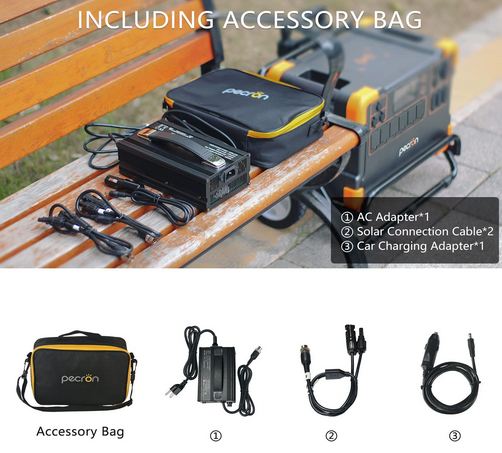
Weighing 56.2lbs, the Pecron E3000 is not the most portable solar generator. But it’s lighter than many other 3kWh solar generators like the Yeti 3000X and EcoFlow Delta Pro.
One or two people can carry it to and from a truck or car when camping. It comes with built-in handles.
For easier portability, Pecron sells a trolley for the E3000.
While the E3000 is not waterproof, it is a bit more rugged than most power stations. It has a hardy exterior and all the outlets and inlets are capped.
Issues & Limitations
Limited Portability
While not as heavy as some solar generators we have reviewed, the EP3000 is still quite heavy. If you are looking for a lightweight solar power station you can easily lift and carry, especially when you are outdoors, this is not it.
Can’t Charge With One Solar Panel
The main PV input ports have a voltage range of 32V to 95V. That means a single 12V solar panel (18-20V open circuit voltage) will not reach the minimum required voltage and thus won’t charge the power station.
You need at least two solar panels or one 24V solar panel.
You can only use a single panel if you plug it into the small 5521 DC input and that requires a different kind of cable from the usual MC4.
Limited Lifespan Li-ion Battery
The Li-ion battery in the E3000 is great for portability. But it doesn't do so well when it comes to longevity.
Pecron says the E3000 has a cycle life of 1000 cycles to 80% capacity. In contrast, LiFePO4 batteries have a cycle life of 3000+ cycles to 80% capacity.
But if you only plan to use the E3000 occasionally, you’ll still get many years out of it. But if you are a daily user, I recommend a solar generator with a longer lasting battery chemistry.
Not Expandable
Many of the high-capacity solar generators we have reviewed like the EcoFlow Delta Pro, the Goal Zero yeti 3000X and the Bluetti AC200MAX are expandable.
If you need more capacity, you don't have to get a second solar generator. You just buy additional battery packs and connect them to the solar generator. It’ll be like having one big battery bank.
The Pecron E3000 doesn't have this option. If you think you might need additional capacity in the future, consider another power station.
Top 3 Alternatives To The Pecron E3000
Not sure the Pecron E3000 is what you are looking for? Here are three alternatives to consider.
1. EcoFlow Delta Pro — More Power & Expandable
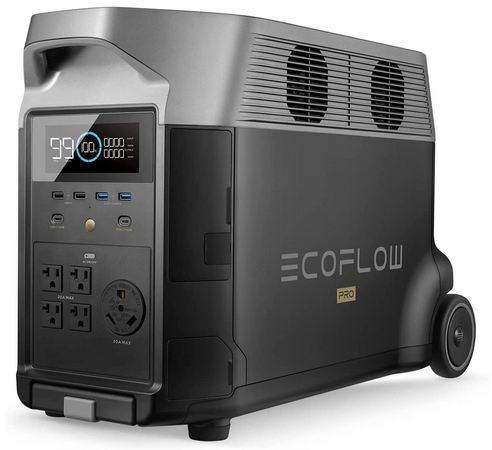
If you need more power and capacity than the Pecron E3000 offers, the EcoFlow Delta Pro is a great alternative.
It has a capacity of 3600Wh, about 500Wh more than the E3000. But unlike the E3000, you can expand the Delta Pro up to 25kWh.
The Delta Pro comes with a higher power output of 3600W, so it can easily power multiple large appliances.
Similar to the E3000, the Delta Pro offers plenty of outlets and charging options. It has dual charging and can even charge from an EV station.
The Delta Pro is equipped with a LiFePO4 battery that lasts much longer than the one in the E3000.
On the downside, the Delta Pro is heavy. It weighs 98.8lbs. It’s certainly not the best choice for camping or outdoors.
2. Pecron S1500F — Lightweight & Portable
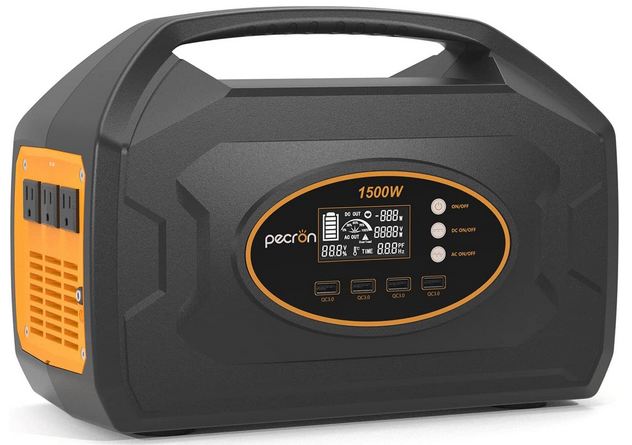
If you love the Pecron brand but prefer something lighter and more portable, get the Pecron S1500F.
Weighing just 25lbs, the Pecron S1500F is perfect for camping and other outdoor adventures, as long as you are willing to make do with less power and capacity.
The Pecron S1500F has a capacity of 1461.6Wh and produces up to 1500W from its 3 AC ports. While nowhere as capable as its bigger sibling, the S1500F can still run most appliances. But it’s more suited to powering the smaller appliances you carry when going camping or fishing.
3. Bluetti AC200MAX — Long Lasting Battery
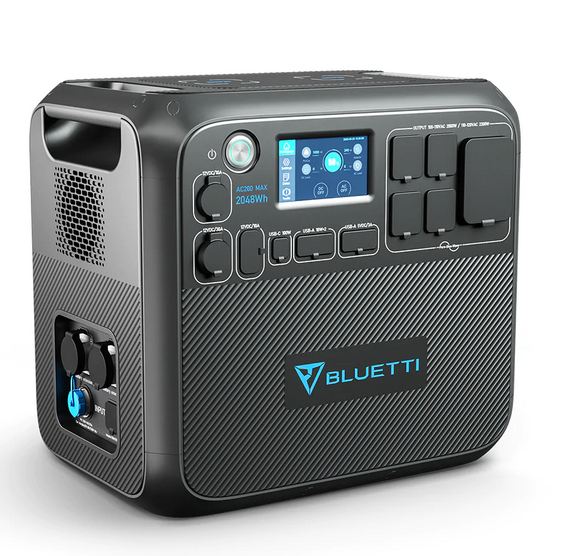
The Bluetti AC200MAX is another good alternative to the Pecron E3000 for those who want a longer lasting power station.
Bluetti says the LiFePO4 battery is good for 3500+ cycles before capacity drops to 80%.
The Bluetti AC200MAX has a capacity of 2048Wh and an output of 2200W, so it can power most household appliances.
And if you need more capacity, there are battery packs you can link to the AC200MAX to expand it to 6144Wh.
The main drawback of the AC200MAX is the weight. Because of the LiFePO4 battery chemistry, it is heavier (62lbs) than the Pecron E3000 despite the fact that it has a smaller capacity.
Care and Maintenance
Lithium power stations don’t need much maintenance. The main thing to worry about when it comes to solar generators is environmental conditions, especially heat.
Do not use, charge or store the E3000 in extreme temperatures. The user manual recommends a charging temperature of 32-113F and a discharging temperature of -4 to 113F.
But try as much as possible to keep the power station at cool temperatures of between 50F and 86F (10-30C).
And when you store it for a long period, make sure you charge it before you put it away and recharge it every 3-6 months.
Warranty
Pecron offers a 1-year warranty on the E3000, which is shorter than the 2-year coverage offered by most other brands.
But if you register on their website, you get an additional year.
Specifications | |
|---|---|
Weight: | 56.2lbs |
Size: | 16.1 x 10 x 11.6 in |
Capacity: | 3108Wh |
AC output: | 2000W continuous, 4000W surge pure sine wave inverter |
Outlets: | 6xAC, 3xUSB-A, 1xQC USB-A, 1x100W USB-C PD, 1x18W USB-C, 3x12V DC, 1 wireless |
Max solar input: | 1200W |
Charging time: | 5-6hrs with AC adapter, 5-6 hours with 800W solar |
Battery chemistry: | Lithium-ion NMC |
Battery lifespan: | 1000 cycles to 80% |
Operating temperature: | -4°F to 113°F (discharge), 32°F to 113°F (charge) |
Where To Buy
You can order the Pecron E3000 from the official Pecron website. It is also available on Amazon.

